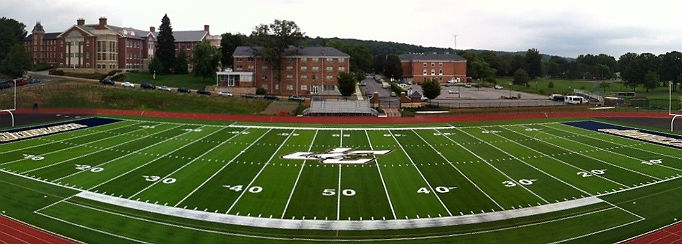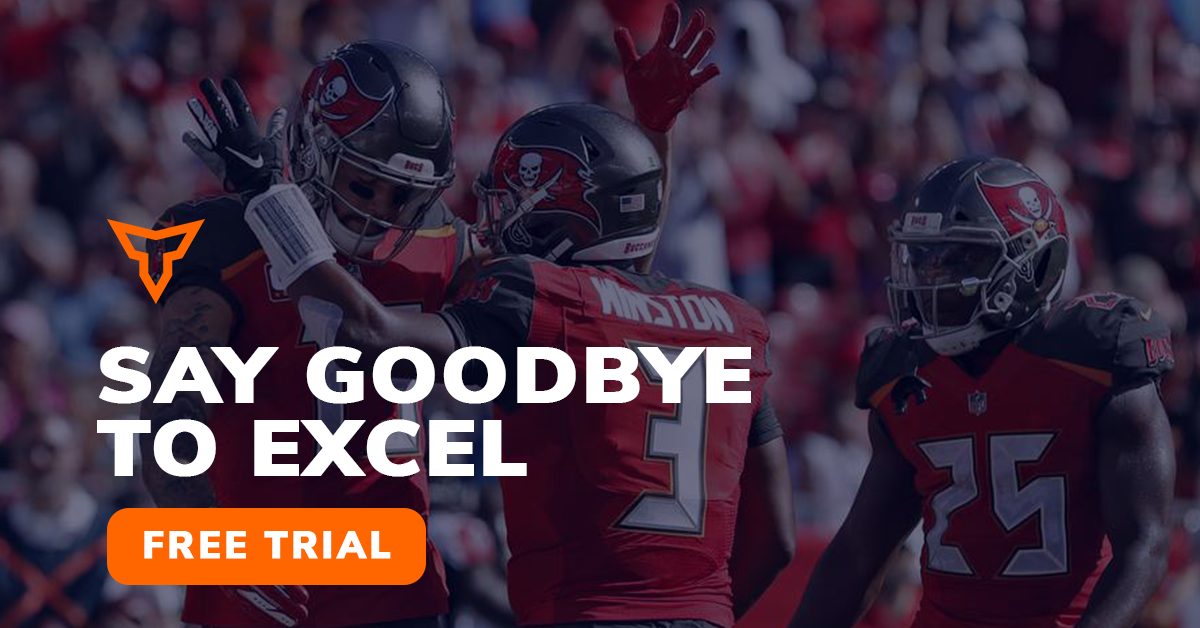Squats vs Deadlifts: Which is Better for Strength, Mass, and Power?
Squats and deadlifts are two of the most popular movements in any Strength Coach’s toolbox. They’re popular lifts because they use a lot of large muscle groups and can develop strength and power like few other exercises can.
But which of these is better for building strength, mass, and power?
As is usually the case with questions like these, the answer is that it depends on several factors including: which sport you play, your individual body type, your goal, and many others.
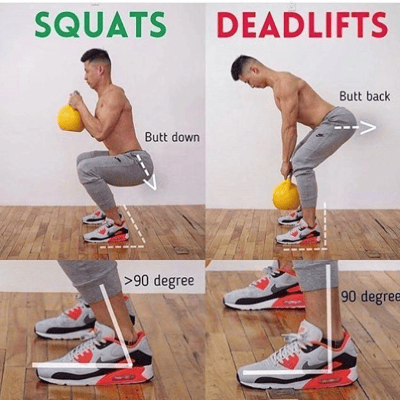
First off, let’s try to define what we mean when we say “strength.” For argument’s sake, let’s say that strength is the ability to produce the most force. (The truth is a lot more nuanced than that, but let’s go with that definition for now.) Strength = how much weight can you move.
And, what about mass? We’ll define mass here simply as the ability for a muscle to hypertrophy or get bigger. There is some evidence that muscles with larger cross-sectional areas can produce more force than those with a smaller cross-sectional area. Again, the truth is much more complex than that, but let’s say here that mass = muscle size.
As for power – that one is pretty simple. It’s the ability to produce force quickly. The more force we can produce, the higher the power we create. The faster we can produce that force, the higher the power also. The ultimate goal for sports performance is to be able to produce the most force possible as quickly as possible. Power = speed and speed is an advantage in almost every sport.
Most strength coaches will build a program around increasing all three of these factors, but when it comes to deciding between squats and deadlifts to improve all of these, we need some more details.
What does the research say?
Studies have shown that each exercise improves the ability to produce force in a specific direction, or vector. So, which exercise is best will depend on which direction the athlete needs to produce force in during their sport. Volleyball players, for example, spend most of their energy jumping vertically, while track and field sprinters spend most of their energy moving horizontally. Other sports like basketball and football actually have a mix of both horizontal and vertical force vectors.
Let’s compare a volleyball player and a track and field sprinter. Both need to increase their strength, their speed, and their power – but they must do it in very different directions.
We can look at EMG studies to figure out which individual muscles are firing more during the squat versus the deadlift. Unfortunately, EMG numbers don’t necessarily equate to motor unit recruitment, meaning, they measure electrical activity, not actual muscle activity. So, it’s a guess that should theoretically be like muscle activation, but it’s not a direct measurement of muscular contraction so, it can’t be used to make assumptions about increases in strength or hypertrophy.
With that being said, an imperfect measure is better than no measure and plenty of studies have been done to look at the differences in muscle recruitment between squats and deadlifts. A study published in the Journal of Strength and Conditioning in 2018 looked at the differences between squats and deadlift kinetics – essentially how much force was applied by the knee and hip joints, respectively, during each exercise.
What they found is no surprise: In back squats, the knee joint has more force on it, and the quads are worked more, whereas during the deadlift, the hip joint has more force and the glutes and hamstrings are worked more. Squats work the quadriceps more, deadlifts work the glutes and hamstrings more.
Several other studies have found similar results. Obviously squats work more than just the quads (the hamstrings, glutes, adductors, core, and other muscles, to name a few), and deadlifts work more than just the glutes and hamstrings (calves, back extensors, lats, shoulders, grip, and others). However, if we're looking for differences between the movements, we can simply say: If we want to work the hips more, we prioritize deadlifts. If we want to work the quads more, we prioritize squats.
Getting back to our concept of the force vector – a study published in Plos One[BMA1] Journal in 2018 looked at vertically and horizontally-directed power exercises and compared their effects on sprint performance and vertical jump height. They found that vertically-directed exercises, like back squats, improved vertical jumping ability more than horizontally-directed exercises. In this study, they used hip thrusts instead of deadlifts, though. Other studies have shown that the deadlift and hip thrust can provide similar strength and performance benefits, as they both primarily target the glutes.
Practical Implications for Strength
When considering which exercise will build the most strength, one of the most important factors is HOW you’re testing that strength.
In the case of our volleyball player – it makes more sense to test them in a way that mirrors their sport, so we’d likely use the squat. If the test you’re using is a 1RM squat, then prioritizing the squat in training is obviously the best choice.
For our sprinter, on the other hand, horizontal force is more important. So, we might choose to test them on a 1RM deadlift or hip thrust (choosing the deadlift is obviously the best). If it’s something else, then you must consider which exercise is MORE specific to the test
Another thing to keep in mind is: what is the athlete LEAST proficient in? So, if you have a volleyball player with big, strong glutes and hamstrings but incredibly weak quads, it makes a lot of sense to use the squat to get them stronger, as this will likely improve their overall strength profile to a greater degree than prioritizing the glutes. However, if the strength is approximately equal, the exercise most specific to the ”test” will almost always produce better results.
So, unfortunately, there isn’t a definitive answer as to whether squats or deadlifts are better for strength. It depends on a lot of factors. The best answer? Do both exercises to make sure you’re strengthening the largest possible number of muscles and identify any areas of underperformance. For reference, most strength coaches consider male athletes to be advanced when they can squat 2x their bodyweight and deadlift 2.5x their bodyweight. Female athletes are considered advanced when they can squat 1.5x their bodyweight and deadlift 2x their bodyweight. If athletes can manage these numbers, it likely makes sense to prioritize the exercise which is most sport-specific for them.
What we do know is that increasing lower body strength will almost certainly improve sprinting abilities. A systematic review and meta-analysis published in 2014 found a “very large significant correlation (r = -0.77; p = 0.0001) between squat strength ES and sprint ES.”
So, if you want to get faster in any sport, get stronger. Remember back to how we defined power – the ability to produce a lot of force very quickly. Strength is the first part of that. So, if we can increase strength, we can increase power (and therefore speed).
Practical Implications for Mass
As we’ve discussed, it depends on your goal. If you want to make your quads bigger, you should probably prioritize the squat. If you want bigger glutes, the deadlift or hip thrust is likelier to help you achieve that. If you think a single exercise is going to make everything bigger, you are sadly mistaken.
Since most athletes aren’t ONLY concerned with big legs, we won’t spend a ton of time talking about building mass. Even though studies have shown correlations between muscle cross-sectional area and force-production ability (ie strength), it’s a bit of a chicken and egg scenario. Are big legs, strong legs? Or are strong legs naturally bigger? Should we prioritize hypertrophy over strength?
The answer is complicated, but the truth is we should likely aim for both. Size DOES contribute to strength, so we should spend time working on muscular hypertrophy. But we also must spend time at the higher end of our loading range in order to build maximal strength. In order to get better at lifting heavy stuff, we have to lift heavy stuff, right? This is why most periodization models take athletes through a hypertrophy phase before a strength phase, and generally finish with a power phase. We must build a foundation for size, then increase the strength of the muscles in order to maximize power output.
It’s also why most studies looking at maximum strength and power variables often try to use participants with lots of training experience. In the end, achieving overall leg size comes down to training multiple exercises – squats, deadlifts, hip thrusts, single leg work – as well as multiple loading schemes. That’s why everyone talks about “the art and science” of strength and conditioning coaching.
And Power?
By now, you can probably guess which exercise is better for maximizing power output, right? You guessed it – it depends. As we’ve touched on multiple times, you must focus on what is most specific to the athlete and their sport, but ESPECIALLY so when training for power.
Most power phases come at the end of a training cycle, close to the time when an athlete is supposed to be “peaking” - and so it remains critical to train the movement patterns and contraction velocities that are going to mirror their sport most closely.
Ok, by now you’re tired of hearing “it depends.” And you probably understand that we should be utilizing both squats and deadlifts when training athletes, but prioritizing the exercise which is most specific to their sport.
What are some considerations for coaches when putting together their programs?
- Single leg options – most sports involve speed, power, and agility that come from a single leg, rather than both legs at the same time. We should train a wide variety of single leg variations:
- 1-leg Squat Variations: Pistol Squat, Step-ups, Bulgarian Split Squats, Box squats, Leg Press, Quad Extension
- 1-leg Deadlift Variations: 1-leg RDL, 1-leg hip thrust, machine kick-backs
It can be a challenge to coach a group of 20 or more athletes on proper form all at once, and resources at some locations can be limited. So, here are some easier alternatives to incorporate with big groups, newbies, and in spaces without lots of equipment:
- Goblet Squats – Anteriorly loaded squats often fix ”poor form” without having to do any coaching at all. You can control the depth to only what the athlete can control, with the goal to get the thighs parallel to the floor or deeper.
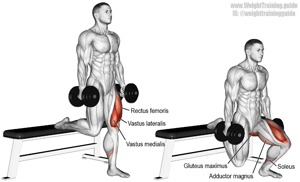
- Bodyweight Bulgarian Split Squats/Rear Foot Elevated Lunges– A simple way to start training single leg work, especially if equipment is limited. Makes sense early in a program for balance, coordination, and foot-strengthening as well.
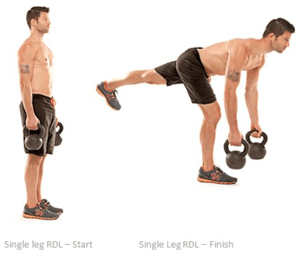 D-bell Single Leg RDL – Loading the hip hinge pattern in this way not only challenges the sagittal plane, but also stability in the transverse plane.For athletes with stability or motor control issues, using a hand-supported version may be advisable.
D-bell Single Leg RDL – Loading the hip hinge pattern in this way not only challenges the sagittal plane, but also stability in the transverse plane.For athletes with stability or motor control issues, using a hand-supported version may be advisable.- Weighted Sit-to-Stand or Pin Squats – These variations can be used to load partial ranges of motion while athletes work to gain control over full depth squats. Can even be used for max strength/heavy half squats to overload the muscles.
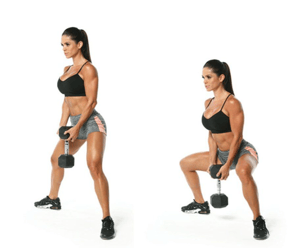
- Sumo Squats – For athletes with relatively longer femurs than torsos (you know – all legs, no torso), squatting to parallel can be a nightmare. Starting with the hips externally rotated functionally shortens the femurs and will generally allow them to get much better depth with much better form. As an added bonus, this variation may increase glute activation.
- Barbell Rack Pulls/Block Pulls – The pin-squat version of the deadlift can be used in a similar way. Load a partial range of motion that the athlete can control and add eccentric and/or isometric work to help increase the range of motion the athlete can control. Can also be used for supra-maximal loading in max strength phases.
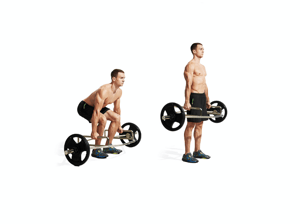
- Trap Bar/Hex Bar Deadlifts and Squats – The trap bar is one of my favorite tools for both of these exercises. It allows athletes to keep the load closer to their hips and decreases sheering forces on the spine. Now, that may come at a cost to maximal glute tension, but the improvement in form and increased lat activation, in addition to the neutral shoulder position (instead of internal rotation with a barbell), makes this variation an excellent alternative.
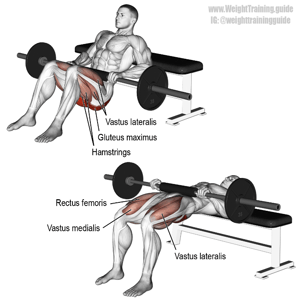
- Barbell Hip Thrusts – These are a nice compliment to the deadlift and should likely be performed in conjunction with them to maximize strength throughout the range of motion. These can also be done in a smith rack, with a landmine, or with bands.
- Kettlebell Deadlifts and variations – When you don’t have enough barbells, or you’re just trying to teach the movements, kettlebells can be great for teaching the hinge pattern and eventually progressing to kettlebell swings for power and explosiveness.
Other Considerations:
When training for maximum strength, utilize all the tools in your toolbox, including band-assisted variations like at the very bottom of a deep squat, and accommodating resistance with things like chains (to maximize strength in lockout positions). Research isn’t clear on the benefit, and this is probably best left for advanced athletes, but if you have those that need additional stimulus for strength, this is a decent option.
When training for mass, aim for higher volume loads (sets x reps x weight on bar) and choose exercise variations that allow form to be maintained. This is when heavy half squats and block pull deadlifts can be of great use. If you have the capability, utilizing blood flow restriction training for accessory exercises like isolated quad and hamstring work can help improve hypertrophy as well.
When training for power with explosive variations like jump squats and broad jumps, be mindful of total volume and obviously, the force vector that you’re training. Our volleyball players and basketball players should likely be prioritizing vertically-directed power exercises like jump squats, drop jumps, and hopping, while track sprinters and soccer players will likely want to prioritize horizontally-directed exercises like broad jumps, kettlebell swings, and bounding.
Also consider using cluster sets (breaking your normal volume of say, 6 reps per set into 2 “mini sets” of 3 reps with some rest in between) with large groups during power phases, as this will allow more athletes to train simultaneously, while keeping contraction velocities higher to better train power and rate of force development.
So, what’s the final word? Which exercise is best for strength, mass, and power? ALL OF THEM!
Combine the global multi-joint moves like squats, deadlifts, and hip thrusts with lots of single leg work and some single-joint isolation moves as well. Vary your rep ranges and loading schemes based on what phase of training you’re in and utilize power exercises that are specific to the force vector your athletes will utilize the most. Taking a balanced, nuanced approach will always yield the best results.
And remember – use your powers for good!
References:
Andersen, Vidar, et al. "Electromyographic comparison of barbell deadlift, hex bar deadlift, and hip thrust exercises: a cross-over study." The Journal of Strength & Conditioning Research 32.3 (2018): 587-593.
Choe, Kevin H., et al. "Hip and Knee Kinetics During a Back Squat and Deadlift." Journal of strength and conditioning research (2018).
Contreras, Bret, et al. "Effects of a six-week hip thrust vs. front squat resistance training program on performance in adolescent males: a randomized controlled trial." Journal of strength and conditioning research 31.4 (2017): 999-1008.
Ebben, William P. "Hamstring activation during lower body resistance training exercises." International journal of sports physiology and performance 4.1 (2009): 84-96.
Jiménez-Reyes, Pedro, et al. "Relationship between vertical and horizontal force-velocity-power profiles in various sports and levels of practice." PeerJ 6 (2018): e5937.
Loturco, Irineu, et al. "Vertically and horizontally directed muscle power exercises: Relationships with top-level sprint performance." PLoS One 13.7 (2018).
Oranchuk, Dustin J., et al. "Comparison of the hang high pull and loaded jump squat for the development of vertical jump and isometric force-time characteristics." The Journal of Strength & Conditioning Research 33.1 (2019): 17-24.
Seitz, Laurent B., et al. "Increases in lower-body strength transfer positively to sprint performance: a systematic review with meta-analysis." Sports medicine 44.12 (2014): 1693-1702.
Thompson, Brennan J., et al. "Barbell deadlift training increases the rate of torque development and vertical jump performance in novices." The Journal of Strength & Conditioning Research 29.1 (2015): 1-10.
Wallace, Brian J., Jason B. Winchester, and Michael R. McGuigan. "Effects of elastic bands on force and power characteristics during the back squat exercise." The Journal of Strength & Conditioning Research 20.2 (2006): 268-272.
Zweifel, Michael. "Effects of 6-week Squat, Deadlift, and Hip Thrust Training Programs on Speed, Power, Agility, and Strength in Experienced Lifters." (2015).
Zweifel, Michael B., et al. "Effects of 6-week squat, deadlift, or hip thrust training program on speed, power, agility, and strength in experienced lifters: A pilot study." Journal of Trainology 6.1 (2017): 13-17.
Subscribe to our blog
Subscribe to receive the latest blog posts to your inbox every week.
Related posts
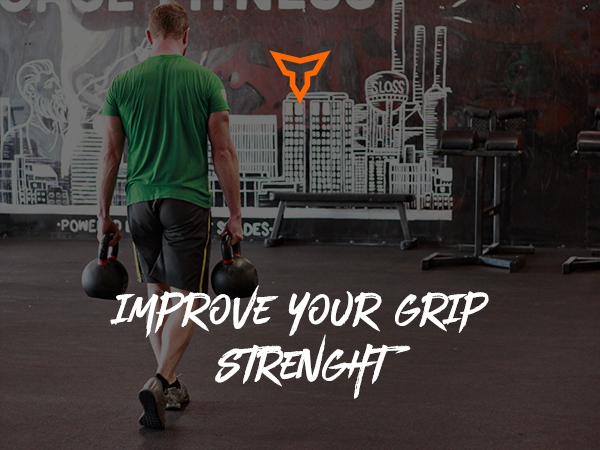
The Importance of Grip Strength
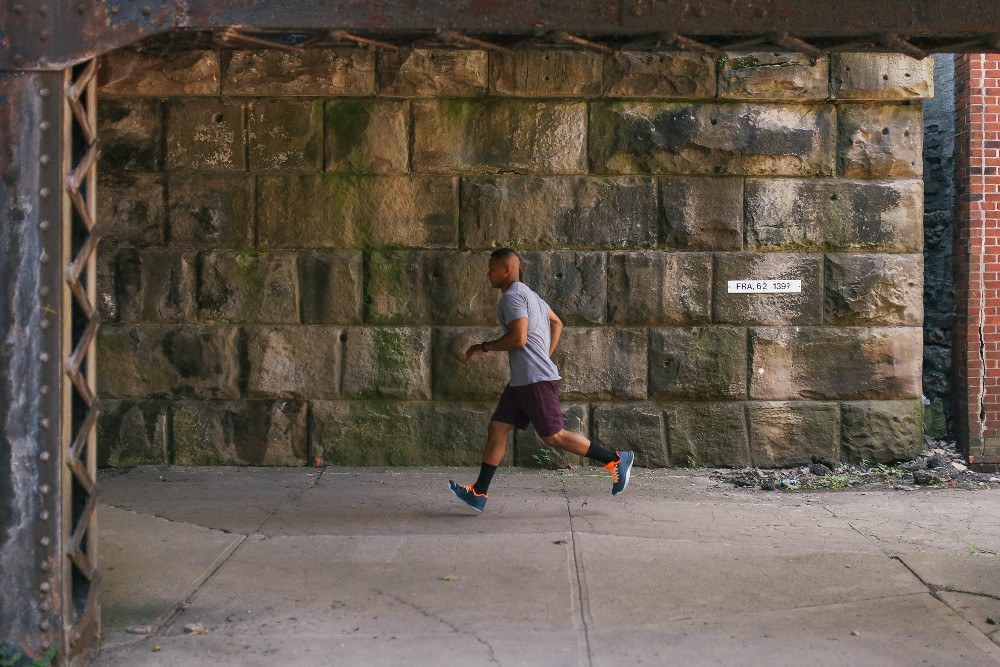
3 Mental Strength Tips For a Great Training Session
